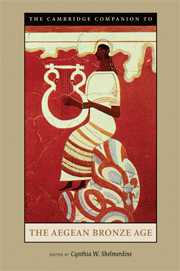Book contents
- Frontmatter
- 1 Background, Sources, and Methods
- 2 The Early Bronze Age in Greece
- 3 The Early Bronze Age in the Cyclades
- 4 Early Prepalatial Crete
- 5 Protopalatial Crete
- 6 The Material Culture of Neopalatial Crete
- 7 Minoan Culture: Religion, Burial Customs, and Administration
- 8 Minoan Crete and the Aegean Islands
- 9 Minoan Trade
- 10 Early Mycenaean Greece
- 11 Mycenaean Art and Architecture
- 12 Mycenaean States
- 13 Burial Customs and Religion
- 14 Mycenaean Greece, the Aegean and Beyond
- 15 Decline, Destruction, Aftermath
- Glossary
- Select Bibliography
- Index
- Plate section
1 - Background, Sources, and Methods
Published online by Cambridge University Press: 28 November 2010
- Frontmatter
- 1 Background, Sources, and Methods
- 2 The Early Bronze Age in Greece
- 3 The Early Bronze Age in the Cyclades
- 4 Early Prepalatial Crete
- 5 Protopalatial Crete
- 6 The Material Culture of Neopalatial Crete
- 7 Minoan Culture: Religion, Burial Customs, and Administration
- 8 Minoan Crete and the Aegean Islands
- 9 Minoan Trade
- 10 Early Mycenaean Greece
- 11 Mycenaean Art and Architecture
- 12 Mycenaean States
- 13 Burial Customs and Religion
- 14 Mycenaean Greece, the Aegean and Beyond
- 15 Decline, Destruction, Aftermath
- Glossary
- Select Bibliography
- Index
- Plate section
Summary
Background
The scope of this book is the Aegean Bronze Age: the history and material cultures of Crete, the Greek mainland, and the Aegean islands during the period when bronze had replaced stone as the dominant material for tools and weapons, and had not yet been supplanted by iron. The period began around 3100/3000 bce and continued until about 1070 bce; during its course different groups of people rose from basic subsistence to cultural prominence, interacted with each other and with civilizations around the Mediterranean basin, and subsided again beyond our reach. Serious study of the Aegean Bronze Age began over 120 years ago, fueled by several early projects, including exploration by the French on Santorini, the British at Phylakopi on Melos, and Heinrich Schliemann at Troy, Mycenae, and Tiryns. Schliemann was motivated by a fascination with mythical accounts of the Trojan War, and Sir Arthur Evans, the excavator of Knossos, by curiosity about the signs, in an unknown script, incised into lumps of clay found on Crete.
None of these pioneers could have imagined the quantities of sites and artifacts that would subsequently be found, the proliferation of new techniques for everything from excavation itself to scientific dating and provenience studies, or the textual information revealed by the decipherment of the Mycenaean script. Early investigators of the Bronze Age tried to characterize and contrast the material culture of different ethnic groups, with special attention to aspects that could be mapped onto a Homeric vision of the Greek past (Ch. 5, pp. 105–6).
- Type
- Chapter
- Information
- The Cambridge Companion to the Aegean Bronze Age , pp. 1 - 18Publisher: Cambridge University PressPrint publication year: 2008
- 4
- Cited by

